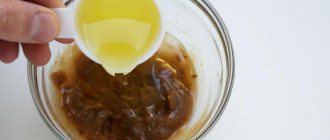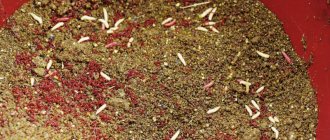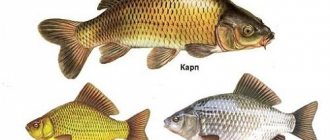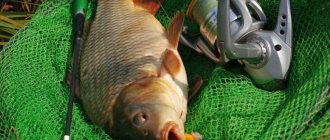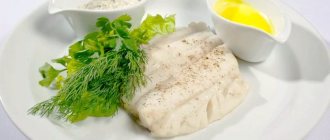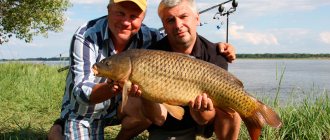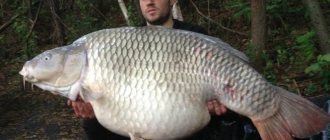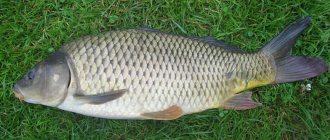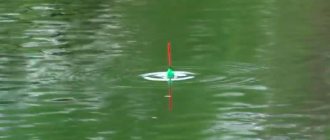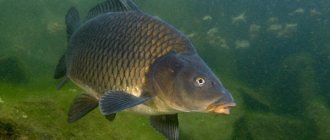Carp photo
Carp is a cultivated form of carp. In contrast, carp have a taller body, faster growth and better feed efficiency.
The head is small. The back is dark green, the sides are yellowish, the fins are gray, and the lower edges of the caudal and ventral fins are reddish. As a result of centuries-old selection, the scaly cover of carp varies from complete to almost complete absence. Mouth with thick lips, retractable. There are 2 pairs of antennae at the corners of the mouth.
Carp is a freshwater fish , but can live at water salinity of up to 9–10‰. For reproduction, water salinity should not exceed 2‰. Prefers low-flow and stagnant bodies of water. Adult carp are cautious and timid, but quickly get used to humans. He easily develops various conditioned reflexes: to the time and place of feeding, sound, etc.
Puberty occurs in Siberia at the 4-5th year of life, in the southern regions - 1-2 years earlier. Males mature a year earlier than females. The fertility of carp is high. Relative fertility is 180 thousand eggs per 1 kg of mass.
Spawning occurs in stagnant water at temperatures above 17°C, but is also observed at lower temperatures. Females lay eggs on freshly flooded vegetation. The development of eggs lasts 3-6 days, and sometimes more. From the 2nd day of life, hatched larvae switch to feeding on protozoa, rotifers, and young crustaceans. The larvae switch completely to external nutrition on the 4th-6th day of life. The transition to benthic nutrition in juveniles occurs gradually and is completed at the end of the first summer of life. From the second summer, the main food of carp is benthos, but large forms of zooplankton are readily eaten by them. In pond farms, it consumes human feed well. This gives grounds to talk about the omnivorous nature of carp, although it grows especially quickly on food of animal origin.
Under optimal conditions, during the first summer, carp can reach a weight of more than 400-800 grams , and over 1 kg during the second summer. In full-system pond farms and fish hatcheries, to obtain a large number of fish per unit area, fingerlings are grown up to 25-30 g, and two-year-olds - up to 400-500 g. In pool farms on warm waters, carp reaches 600-700 g in 6-8 months Carp lives for quite a long time, according to some sources, up to 50 years, and can grow up to 50 kg. In fish farms, mature carp usually weigh 3.5-10 kg, so they are kept for up to 10-14 years.
Currently, carp is the most common pond fish not only in our country, but also in the world. It accounts for about 50% of global fish production in fish farms.
Based on their scaly cover, the following types of carp are distinguished: scaly and mirror (scattered, linear, naked or leathery). Based on body shape, carp are divided into high-back and broad-back. This determines their meat quality (yield of edible parts).
Currently, the following carp breeds are approved in our country.
Sarboyan carp
Sarboyan carp (authors of the breed: Korovin V.A. and Zybin A.S.). The first Siberian breed, approved in 1987. Bred in Western Siberia. Currently, it has proven itself well in other regions of the country. Belongs to the group of broad-backed carp. The ratio of height to length is 1:2.5-1:2.75. Head length no more than 1/5 body length. The scaly cover is continuous. It is distinguished by high fertility - 80-310 thousand larvae during natural spawning and more than 475 thousand during hatchery spawning.
Winter hardiness is high - no less than 94.5%. Spawning is observed even at temperatures below 16°C. Resistant to oxygen deficiency. During the short Siberian summer it is able to reach a standard weight, both at the fingerling and two-year stages. Pays well for growth with feed added to the water. Sarboyan carp has an admixture of blood from Amur carp and Ropsha carp. Currently, the breed has 3 types (layering): northern, Omsk and steppe.
Sarboyan carp video
Breeds of carp and how they differ from carp
We are all accustomed to the fact that carp fishing comes to us from England. This type of fishing is also very popular in France, Croatia, Romania, Belgium and other European countries. In the 90s, carp fishing gradually reached our country, but if we talk about the carp population itself, then everything is exactly the opposite!
The habitat of these fish is the southern part of China and Southeast Asia. With the exception of two species, namely the carp, which lived in the Far East and in the reservoirs of the Black, Caspian and Aral Seas, and the second is the silver carp from Lake Balkhash, which is located in Kazakhstan. There is no talk of England, France or other European countries!
There are about 30 breeds of carp in total! But we will dwell in detail only on some types. The fact is that our goal is not so much to provide full-fledged scientific journalism, but to get a general idea of how things stand with carp species.
Pond fish farming areas
Pond fish farming is divided into six zones. They are divided according to the number of days in a given region with temperatures above 15 degrees. The first zone lasts only 60-75 days, so profitable commercial fish farming is focused primarily on whitefish and cold-water trout.
First fish farming zone
Buryat Republic - southern part Udmurt Republic - southern part Krasnoyarsk Territory Khabarovsk Territory - southern part Tver Region Ivanovo Region Kemerovo Region Novosibirsk Region Omsk Region Pskov Region Moscow Region - northern part Nizhny Novgorod Region - northern part Irkutsk Region - southern part Vyatka Region - southern part Kostroma region - southern part Leningrad region - southern part Perm region - southern part Sverdlovsk region - southern part Tyumen region - southern part Chita region - southern part Yaroslavl region - southern part
The second zone already includes 76-90 days with temperatures above 15 degrees.
Second fish farming zone
Republic of Bashkortostan - northern part Republic of Tatarstan - northern part Jewish Autonomous Region Khakass Autonomous Okrug Altai Territory Vladimir Region Kaluga Region Kurgan Region Ryazan Region Smolensk Region Tula Region Chelyabinsk Region Moscow Region - southern part Nizhny Novgorod Region - southern part
The third zone and 91-105 days with temperatures above 15 degrees!
Third fish farming zone
Republic of Mordovia Republic of Bashkortostan - southern part Republic of Tatarstan - southern part Primorsky Territory - southern part Bryansk region Kursk region Lipetsk region Oryol region Penza region Samara region Tambov region Ulyanovsk region Ryazan region - southern part
The fourth zone - 121-135 days with temperatures above 15 degrees
Fourth fish farming zone
Belgorod region Voronezh region Orenburg region Saratov region
The fifth and sixth zones are 136-150 days with temperatures above 15 degrees.
Fifth fish farming zone
Republic of Kabardino-Balkaria Volgograd region Rostov region
Sixth fish farming zone
Republic of Dagestan Republic of Kalmykia Republic of Chechnya Krasnodar Territory Stavropol Territory Astrakhan Region
It is these zones that are the most prolific for carp production, which can amount to more than 2 tons per hectare. As for fish farming zones 2, 3 and 4, they can also be successful if good temperature and hydrochemical conditions are maintained and fish production technologies are followed.
Altai mirror carp
A very prolific breed. An individual 5 years old is capable of producing about 700 thousand eggs per spawning. This breed of carp has been known in Altai since the 30s of the last century. From that time on, breeding work was carried out with this carp, which lasted until 1994. This breed is typical for the first and second zones of pond fish farming.
Angelina carp
In 1963, on the territory of the Krasnodar Territory, in the Angelinsky fish farm, a selective campaign was launched to breed a breed of carp that would be highly immune to diseases characteristic of fish. The reason was the high percentage of individuals suffering from rubella.
It is worth noting that it took about 10 generations before the fish was included in the State Register. This breed is highly resistant to rubella, the photo shows mirror carp, but there are also scaly breeds. The fertility of one adult female is about 600-650 thousand eggs.
Parsky carp
This breed was developed by crossing domesticated carp with Amur carp, resulting in Parsi carp, which is highly fertile. Females of Parsi carp exceed the norm by 2.5 times in terms of the number of eggs. There are also two types: scaly and with scattered scales (that’s the correct name!). The second was obtained as a result of crossing the Ukrainian framed carp with the scaly Parsi carp, which had already been bred by that time. This breed is typical for the second, third and fourth fish farming zones. Fertility is about 800-1200 thousand eggs.
Moscow carp
This is a subspecies bred from Parsi carp, which is characterized by increased resistance to frost. The selection was carried out under conditions of harsh, long winters and short, cool summers. Brought to the Moscow region from the Ryazan fish farm “Para” in the early 80s. The main difference is the runaway body, easy tolerance of oxygen deficiency and acclimatization to sudden temperature changes. Very high resistance to various diseases. These carp breeds are typical for the first and second fish farming zones. Working fertility, even in cold winter conditions, for a 5-year-old female is about 1000 thousand eggs.
White amur
Simply put, grass carp. But in fact, this fish is a genetically marked Amur carp. Despite the fact that cupids actively feign a heart attack after a photo shoot, this species is distinguished by its amazing vitality. Therefore, you should not follow the lead of the cunning and insidious fish, help it come to its senses and let it go, everything will be fine with the cupid!
Initially, the habitat of grass carps was Eastern Asia in the Amur River basin and the lowland rivers of China. It ranks first in the world in terms of commercial cultivation volumes. Also lives in the lower reaches of the Volga, on the middle and lower reaches of the Don and the Dnieper-Burg estuary.
Other carp breeds
Sarobyan carp
This breed was specially bred for Western Siberia. Belarusian mirror carps, Amur carp and other species were used as source materials.
Tatay carp
One of the oldest carp breeds in Hungary, which was bred back in the 19th century. In the middle of the 20th century it was brought to the Hungarian Research Institute in the city of Szarvas. The breed was improved there. In the 80s it was brought to the USSR, namely to Ubekistan and the Stavropol Territory. A distinctive feature is the extremely low percentage of fat contained in its body.
Frame carp
They were brought out in the Tula region. This breed was bred in order to adapt the fish to reproduction in cages and stalls, which have a limited area and warm water. There are both scaly and scattered versions of the fish.
Difference between carp and carp
Carp is a fish that inhabits rivers and other bodies of water as a result of its natural residence there, based on the habitat halos of carp, which we wrote about above. So, the rivers of the Black, Caspian and Aral seas. All the carp that live there are carp. All carp that are found outside such rivers are domesticated carp, which were brought there artificially and then bred from generation to generation - they are called carp.
Rivers of the Black Sea
Agura is a river in the Khostinsky district of the city of Sochi, Krasnodar Territory. The Dnieper is a river in Eastern Europe (Russia, Belarus, Ukraine). Tributaries of the Dnieper Berezina - right tributary of the Dnieper, Smolensk region Berezina - right tributary of the Dnieper, Belarus Vop - right tributary of the Dnieper Vyazma - left tributary of the Dnieper Sveta - left tributary of the Vop River Desna - left tributary of the Dnieper Osma - left tributary of the Dnieper Bolva - left tributary of the Desna Snov - left tributary of the Desna Navlya - left tributary of the Desna Revna - left tributary of the Again Nerussa - left tributary of the Desna Revna - left tributary of the Desna Sev - left tributary of the Nerussa Seym - left tributary of the Desna Snopot - left tributary of the Desna Svapa - right tributary of the Seim Kleven - right tributary of the Seim Usozha - left tributary of Svapa Tuskar - right tributary of the Seim Sudost - right tributary of the Desna Shostka - left tributary of the Desna Sozh - left tributary of the Dnieper Berezina (Berezovka) - left tributary of the Sozh Vihra - right tributary of the Sozh Khmara - left tributary of the Sozh Oster - left tributary of the Sozh Besed - left tributary Sozh Iput - left tributary of the Sozh Dagomys (Kuban) - river in the Lazarevsky district of Sochi, Krasnodar Territory Kudepsta - river in the Khostinsky district of Sochi, Krasnodar Territory Western Dagomys - river in the Lazarevsky district of the urban district of Sochi, Krasnodar Territory Eastern Dagomys - river in the Lazarevsky district of the urban district Sochi, Krasnodar Territory Loo - a river in the Lazarevsky district of Sochi, Krasnodar Territory Mzymta - a river flowing in the Krasnodar Territory Psou - a river in the Krasnodar Territory, a natural border with Abkhazia Sochi - a river in the Krasnodar Territory Tuapse - a river in the Tuapse district of the Krasnodar Territory Khosta - a river in Khostinsky Sochi district, Krasnodar Territory Bolshaya (Eastern) Khosta - a river in the Khostinsky district of Sochi, Krasnodar Territory Malaya (Western) Khosta - a river in the Khostinsky district of Sochi, Krasnodar Territory
Rivers of the Caspian Sea
The Volga is a river in the European part of Russia, flowing through the territory of 11 regions and 4 republics. Kama - a left tributary of the Volga Belaya - a left tributary of the Kama Oka - a right tributary of the Volga Terek - a river in Russia and Georgia Ural - a river in the Republic of Bashkortostan and Kazakhstan, as well as in the Chelyabinsk and Orenburg regions. Baral - a river in Bashkortostan, a right tributary of the Urals Birsya - a river in Bashkortostan, a right tributary of the Urals Kurgash - a river in Bashkortostan, a right tributary of the Urals Yuryuzan - a left tributary of Ufa
Regarding the Aral Sea, just in case, it represents one of the worst environmental disasters that occurred in the 20th century. Since the early 1960s, sea levels have been falling rapidly due to water withdrawal from the main rivers that feed it, the Amu Darya and Syr Darya. Before the start of shallowing, the Aral Sea was the fourth largest in the world! Excessive water withdrawal for agricultural purposes has turned the world's fourth-largest lake, rich in life, into a rootless desert. Today, in some places it has gone 100 km from its original coastline.
The problem between Canada and the USA
An interesting story happened to them. The carp that inhabited Lake Balkhash (Kazakhstan) turned out to be so mercilessly tough that after its introduction to Canada and the USA, it created absolute terror, similar to the game that carp create in Australia. (We already wrote about the Australian nightmare in this article). Local fish cannot compete with carp; Americans don’t really catch it because of the abundance of bones and prefer other types of fish.
It got to the point that an electric barrier was built on the Chicago Canal to prevent any carp from entering the Great Lakes system (Erie, Ontario, Huron, Superior, Michigan). Otherwise, it will simply destroy the entire original ecosystem and kill the fishery.
Note
Surely, there are other breeds of carp that we have not mentioned, especially for European breeds. But we tried to provide the most relevant information for our country. We will be grateful if in the comments you share your knowledge of carp breeds, of which, as we have already said, there are about 30.
We also did not touch on the carp breeds that live in Asia. But you can watch our film from Thailand, where Anton purposefully catches the real giants that live in Thailand!
Full or partial copying without the consent of the portal editors is prohibited
Parsky carp
Parsky carp (created by the team of authors Bobrova Yu.P., Voronkova E.B., Elufimova L.A., Golovinskaya K.A., Shchelokova P.M., Timirov N.T., Lavrukhina S.I., Garin A. .G., Polyansky A.A.). Approved as a breed in 1989. Designed for the Central and Central Black Earth zones. It has 2 breedings: local ones with a continuous scaly cover and carp descended from Ukrainian and local carps with scattered scaly cover. Local carps were obtained by crossing outbred carp with Amur carp. They have better winter hardiness. The second layer has a higher growth rate. The fertility of Parsi carp is high - 300-350 thousand eggs per female. The yield of larvae from a female during hatchery reproduction is 150-175 thousand, during natural spawning - 70-120 thousand. The yield of fingerlings is 80%, yearlings -75. The body is runaway. The average weight of females is 8-9 kg.
Varieties of carp:
Wild carp (carp) (lat. Cyprinus carpio) is the original form of carp. All other representatives of the carp family are mutations of this species, caused by many years of crossbreeding experiments in fish farms. Carp lives in fresh lakes and rivers, sometimes found in brackish sea waters. The cunning carp knows how to hide in uneven bottoms, and on a flat bottom it can lie on its side, avoiding the seine. Scaly carp (common) (lat. Cyprinus carpio carpio) has a large, low-set mouth, dense scales, color from brown to gold, depending on the habitat and color of the water. Of all the varieties, the scaly carp shows the highest growth rate. Carp is an unpretentious fish. This breed of fish takes root well in polluted waters and small ponds with low oxygen levels. Mirror carp (royal) (Cyprinus rex cyprinorum) are less common and differ from common carp in their larger, but unevenly distributed scales, forming areas of the body unprotected by scales. The birthplace of fish is Germany. In any body of water, mirror carp avoids the depths. Its favorite habitats are well-warmed and oxygenated shallow waters. Linear carp differ in appearance only by the line of scales located along the body. Linear carp have limited growth potential, a genetic trait that is inherited along with the type of scaly covering. In the presence of an abundant food supply and in warm, well-heated water, linear carp quickly gains fat. In autumn, after the water cools, carp quickly loses accumulated fat and loses weight. Naked or leathery carp (Cyprinus nudus) differs from the other two species in the almost complete absence of scales. Sometimes naked carp are found with several scales located near the dorsal or caudal fins. The back has greenish swamp-colored shades, the sides are bronze-golden. Weight gain occurs much more slowly and is quite rare.
Altai mirror carp
Altai mirror carp was approved as a breed in 1994. Created by a team of authors - Ivanova Z.A., Moruzi I.V., Sapunov L.Ya., Buymov V.M., Prisyazhnykh V.S., Zhukova L.I., Zhdanova N. .AND. The breed was obtained through targeted selection of descendants of Galician carp, brought to the Altai region back in 1932. Altai carp have a mirror-type scaly cover. The body is tall. The offspring are distinguished by high winter hardiness - not lower than 95-96%, feed consumption per 1 kg of growth for underyearlings is 2.8, for two-year-olds - 3.1 kg, which is lower than the standard for the second fish-breeding zone. Fertility is high: with hatchery reproduction 442-887 thousand eggs, with natural spawning - 100-110 thousand 7-day-old larvae. It has a good growth rate and early maturity. At the age of three, all males and 80% of females are sexually mature.
Fishing for mirror carp video
Carp spawning.
For carp, spawning begins late, after the water warms up to 15°C. As the water warms up to 18°C, spawning becomes widespread. Carp, like many other fish, do not spawn immediately, but in two or even three stages, sometimes after a significant period of time. Pond carp always spawn somewhat earlier than river carp (which is due to faster warming of calm water). Carp cannot spawn in completely stagnant ponds, since a slight movement of water and a certain level of oxygen content in it are necessary for proper insemination and development of eggs. Male carp differ from females of the same age by almost half their height and mobility, that is, by a thinner and elongated body.
Ropshinsky carp
ropsha carp
Ropshinsky carp is a breed bred under the leadership of Kirpichnikov A.S. Team of authors – Andriyasheva M.A., Babushkin Yu.P., Dyakova G.N., Zonova A.S., Kirpichnikov V.S., Konradt A.G., Petrov B.G., Ponomarenko K.V. , Slutsky E.S., Tishchenko Yu.F., Faktorovich K.A., Chapskaya M.K. . Designed for the North-Western regions of the country. It is characterized by high winter hardiness, which is determined by the large proportion of blood of Amur and Taparavan carp, which are one of the original species of fish that participated in the creation of this breed. Ropshinsky carp grows somewhat slower than pure carp, but is better suited for this region.
In recent years, a lot of work has been done to create new breeds of carp in Russia. To date, 19 breeds have been registered, such as the Angelinsky, Cherepetsky, Stavropol and other breeds. Prepare for testing Central Russian carp.
In the CIS countries there are Belarusian carp and Alma-Ata carp. Particularly noteworthy are Ukrainian carps. These are the first breeds created in the 60s by I.A. Kuzema.
How to catch carp.
It is useful to attach fish to fishing areas. As a top dressing, you can use steep millet porridge, crackers from leftover bread and steamed barley. Use steamed hemp seeds for bait. In places where balls of bait lie on the bottom, air bubbles soon begin to float up - this means that the fish has approached and begun to feed. Feeding should be added in small portions before fishing and during the period when the bite subsides. During the day you need to change the bait periodically. Silence must be maintained. Large carp prefer silence; they bite in very quiet places, where you can’t even hear the crow of roosters. For successful carp fishing, be sure to carefully read all the tips in our carp biting forecast for your region.
Author of the article: Team of authors of the site orybe.com 2014-01-19
Ukrainian scaled carp
Ukrainian scaly carp belongs to the group of high-backed carp. Fattening type breed. The body is tall, the head is small. The occipital and anal junctions are well developed. The scaly cover is continuous. 40-45% better use of natural food compared to outbred carp. The weight of two-year-olds is 17-18% greater than that of outbreds. The yield of larvae from 1 female is on average 300-600 thousand. Winter-hardy. Sexual maturity in females occurs in the 3rd year of life, in males - in the 2nd. Three-year-olds reach a weight of 3 kg, four-year-olds - 4-6 kg. The yield from wintering ponds is 90-95%.
The Nivchan herd was created on the basis of Ukrainian scaly carp. It was obtained by introductory crossing with Ropsha carp. Nivchan carps have a greenish tint to their scales. They retain early maturity, rapid growth and high fertility, and in addition, they have acquired higher cold resistance and winter hardiness. Well adapted for growing in large river-bed ponds.
Carp is an emigrant from Asia
I read an article on the Internet today, it’s interesting.
The US Congress has refused to allocate money to fight scaly Asian immigrants in Illinois. The senators felt that 16 million was too much, and American fishermen should cope on their own.
Without strong boats and vests, few people would dare to go out on the water here. The emigrant carp from Asia has long appropriated local rivers for itself and does not intend to give up its position without a fight.
Biologist O'Hara, who has been attacked from the water more than once, does not call the situation anything other than a natural disaster in his reports. “There have been cases where these fish have broken ribs, broken noses, knocked out teeth when they jumped, and if you are not prepared, they can actually knock you out of the boat,” he says.
Carp does not tolerate neighbors, quickly and mercilessly destroying all underwater food. It was once released into the ponds of Illinois as an exotic fish, but now the fish that lived here long before the great migration have become exotic.
“This is a really crazy fish - it seems to be nervous all the time and jumps out of the water,” says one of the fishermen.
“Asian carp are a huge problem. It got into this river in the 90s, and its population is growing at an explosive rate. There are already 10,000 individuals per mile. If one fish lays 2,000 eggs, this is a threat to all other inhabitants,” explained Greg Szasz, director of the Illinois River Biological Station.
They are counted by cutting their fins and slightly shocking them with an electric fishing rod, looking around in anticipation of a threat. But this fish is also a strategist - it strikes unexpectedly.
Returning from a fishing trip with a bruise is common in Illinois. Asian carp is an aggressor; it reaches a meter in length and weighs about forty kilograms. But it attacks fishermen from above, flying 2 or even 3 meters out of the water. The indigenous inhabitants of these places have already hastened to retreat.
The "Asian carp case" has reached Congress. After all, small rivers have not been enough for him for a long time. Hordes of fish are jumping through to Chicago - there are the Great Lakes. If a carp gets into them, an environmental disaster cannot be avoided.
“Electric barriers to the Great Lakes are the only option because these fish now need Michigan. And this is the only way we can preserve the traditional inhabitants. But the project will cost millions, says Kevin Irons, a researcher at the Illinois River Biological Station.
